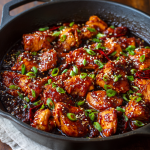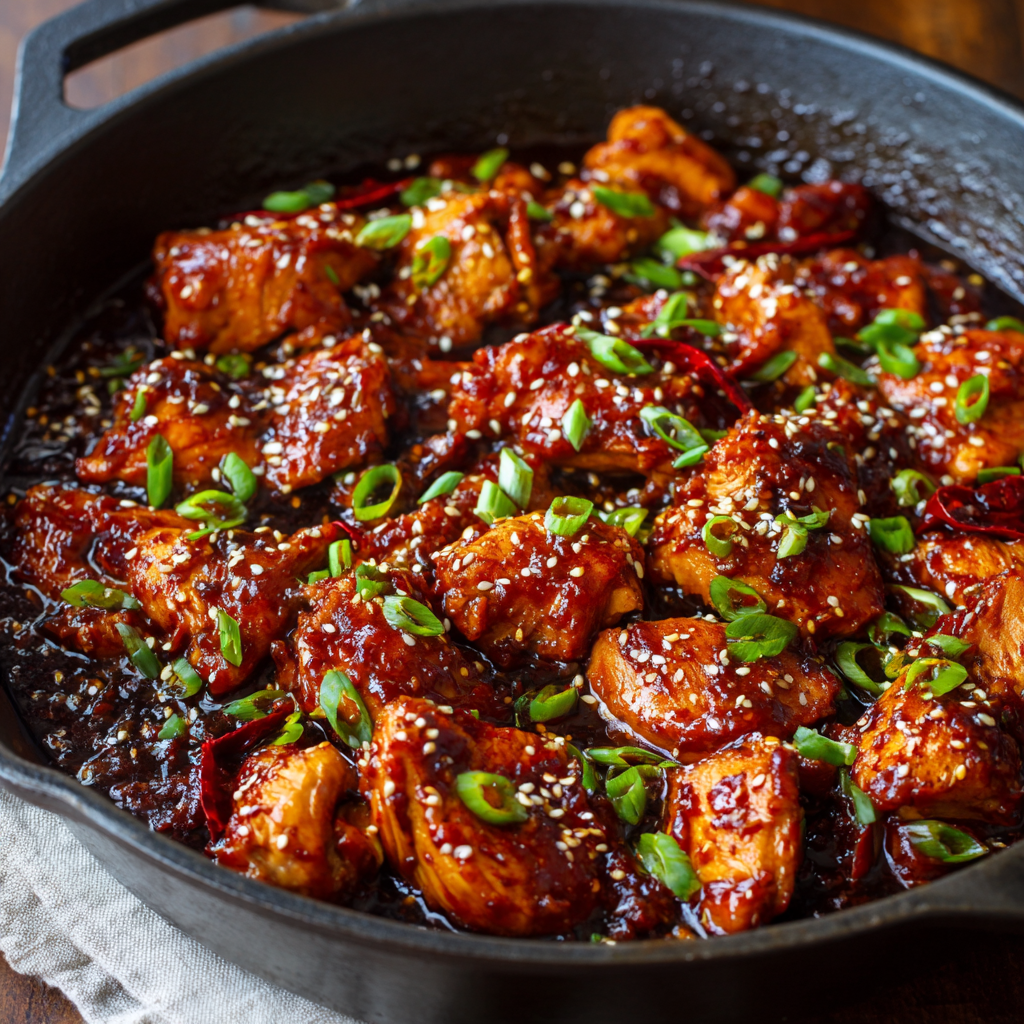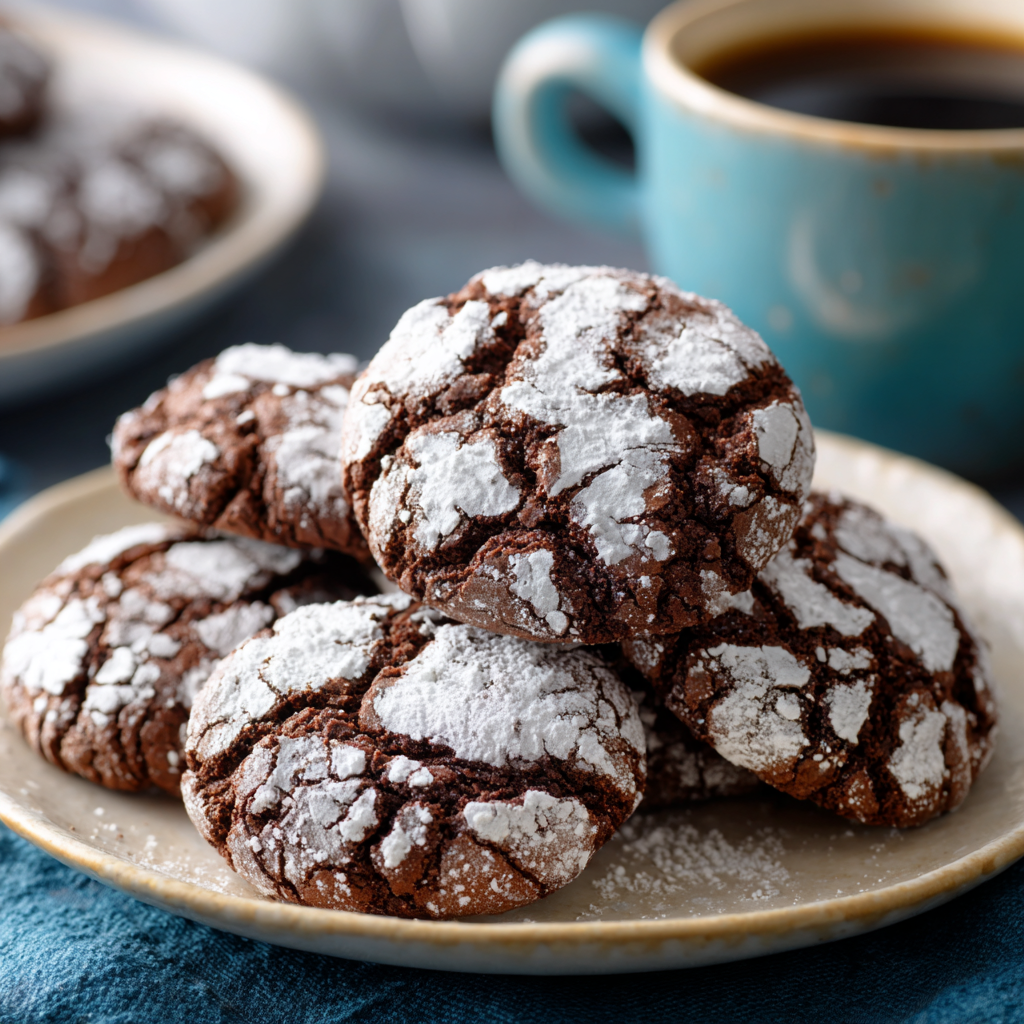Sticky Honey Gochujang Chicken: Your New Weeknight Obsession
Hey there, kitchen friend! Olivia here, waving from my flour-dusted countertop. Can you smell that? It’s the sweet-spicy perfume of caramelizing honey and gochujang hitting a hot pan—a scent that instantly transports me to my happiest place. If you’re craving a dinner that’s faster than takeout but tastes like a flavor fireworks show, you’ve hit the jackpot. This Sticky Honey Gochujang Chicken is my weeknight superhero: 20 minutes, one skillet, and guaranteed empty plates. Imagine tender chicken thighs glazed in a sauce that’s all things magical—fiery from Korean chili paste, golden-sweet from honey, with garlicky depth and that addictive sticky pull. It’s the kind of dish that makes you sneak “just one more bite” straight from the pan (no judgment here!). Whether you’re cooking for picky teens, impressing a date, or treating yourself after a long day, this recipe is your ticket to dinnertime glory. Grab your favorite apron—let’s make magic happen!
The Night I Fell in Love with Gochujang
Picture this: It’s midnight in my tiny first apartment kitchen, rain tapping against the window. My best friend Maya and I just got home from a chaotic double shift at the café, starving and exhausted. We were rummaging through my near-empty fridge—just chicken thighs, a half-used tub of gochujang from a forgotten kimchi experiment, and a bear-shaped honey bottle. “Let’s wing it,” Maya said, already chopping garlic. Twenty minutes later, we sat cross-legged on the floor, chopsticks clacking over a sizzling skillet, giggling as the spicy-sweet sauce made our noses run. That messy, improvised feast became our secret ritual after every tough day. Now, whenever I make this chicken, I still text Maya a photo with the caption: “Emergency comfort food activated.” It’s proof that the best recipes aren’t just about ingredients—they’re about the joy and connection we stir into every bite.
What You’ll Need
- 1½ lbs boneless, skinless chicken thighs – Thighs stay juicy even if you overcook them slightly (unforgiving chicken breasts? Hard pass!). Swap: Chicken breast works if sliced thin, or use tofu cubes for veggie pals!
- 2 tbsp Gochujang (Korean chili paste) – The star! This fermented gem brings heat, umami, and a hint of sweetness. Find it in Asian markets or the international aisle. Spice level: medium-hot. Can’t find it? Mix 1 tbsp sriracha + 1 tbsp miso paste as a quick fix.
- 3 tbsp honey – Balances the heat and creates that glossy stickiness. Chef’s trick: Warm your measuring spoon with hot water first—the honey slides right out! Maple syrup works too.
- 2 tbsp soy sauce – Salty depth that makes flavors pop. Need gluten-free? Tamari is your BFF. Too salty? Use low-sodium soy sauce.
- 2 cloves garlic, minced – Non-negotiable for fragrance! Lazy hack? ½ tsp garlic powder. But fresh is best.
- 1 tbsp vegetable oil – High smoke point = perfect sear. Avocado or canola oil also great. Skip olive oil—it burns too easily here.
- Garnish: Sesame seeds + scallions – These aren’t just pretty! Sesame adds nuttiness, scallions give fresh crunch. No scallions? Try cilantro or thinly sliced radishes.
Pro Tip: Double the sauce ingredients and stash half in a jar—it’s incredible on roasted veggies, shrimp, or even as a burger glaze!
Let’s Get Cooking: Your Foolproof Roadmap
Step 1: Sauce Alchemy! In a medium bowl, combine the gochujang, honey, soy sauce, and minced garlic. Whisk until it’s smooth and looks like molten lava (the good kind!). Chef’s Hack: If your honey is stiff, microwave the jar for 10 seconds first. Taste a dab—adjust honey for sweetness or a splash of rice vinegar for tang if you like!
Step 2: Chicken Sizzle Time! Heat vegetable oil in a large skillet (cast iron or non-stick!) over medium-high heat. Pat chicken thighs super dry with paper towels—this is KEY for golden edges! Add chicken in a single layer (don’t crowd the pan; cook in batches if needed). Sear 6-8 minutes, flipping once, until deeply golden and cooked through. Listen for that satisfying sizzle! No stirring constantly—let it develop a crust.
Step 3: The Sticky Magic Lower heat to medium. Pour that gorgeous sauce over the chicken—it’ll bubble and sputter excitedly! Stir constantly for 2-3 minutes as the sauce reduces into a thick, glossy cloak. Watch closely: When it leaves a trail on the pan bottom when scraped (like parting the Red Sea!), it’s done. Undercook sauce = runny. Overcook = burnt bitterness. Trust your instincts!
Step 4: The Grand Finale Kill the heat. Sprinkle generously with sesame seeds and chopped scallions. Pro Move: Let it rest 2 minutes—the sauce thickens more and clings perfectly.
The Science Behind the Sticky Glaze – Why This Recipe Works
Ever wonder why this Sticky Honey Gochujang Chicken clings to your taste buds like a deliciously persistent koala? There’s actual food science at play here—let’s geek out for a second.
The Maillard Reaction & Perfect Sear
That golden-brown crust on your chicken thighs? Thank the Maillard reaction, the magical chemical process where amino acids and reducing sugars transform under heat, creating complex, savory flavors. Patting the chicken dry before searing isn’t just a fussy step—it ensures maximum browning by eliminating moisture that would otherwise steam the meat. And using high-smoke-point oil (like vegetable or avocado oil) prevents burning while achieving that crisp exterior.
Gochujang: The Umami Bomb
Gochujang isn’t just spicy—it’s a fermented powerhouse of glutamates (natural umami compounds) thanks to its soybean and rice components. When combined with honey’s fructose and soy sauce’s saltiness, it creates a flavor trifecta: sweet, salty, and deeply savory. Fermentation also means gochujang has a subtle tanginess, balancing the richness of the dish.
The Sticky Sauce Secret
Honey isn’t just a sweetener—it’s a natural thickener. When heated, its sugars caramelize and reduce, creating that glossy, clingy texture. Adding the sauce only at the end prevents burning (sugar scorches easily!) while letting the chicken’s fond (those crispy browned bits in the pan) dissolve into the glaze for extra depth.
Why Thighs Triumph
Chicken thighs are forgiving because their higher fat content keeps them juicy even if slightly overcooked. Breasts, with their lean muscle fibers, tighten up fast, leading to dryness. For vegetarians, extra-firm tofu or cauliflower florets work beautifully—just coat them in cornstarch first for a crispy bite.
Pro Tip: For next-level stickiness, add 1 tsp of cornstarch slurry to the sauce—it’ll give you that lacquered takeout-style glaze.
The Cultural Roots of Gochujang – More Than Just a Condiment
Before this ruby-red paste became your fridge’s MVP, it had a rich, centuries-old history in Korean cuisine. Let’s take a quick trip to its origins—and why it’s a global darling today.
From Joseon Dynasty to Your Kitchen
Gochujang’s roots trace back to 18th-century Korea, where it was made in onggi (traditional clay pots) during late winter. Families fermented a mix of chili powder, glutinous rice, fermented soybeans (meju), and salt, then aged it under sunlight for months. This slow fermentation developed its deep umami and subtle sweetness—a far cry from today’s instant sauces!
Gochujang’s Modern Rise
Thanks to Korean pop culture (hello, K-dramas and mukbang videos!), gochujang has gone global. But traditional versions still shine in dishes like bibimbap, tteokbokki (spicy rice cakes), and bulgogi. Unlike Western hot sauces (looking at you, Tabasco), gochujang isn’t just heat—it’s layered complexity with a funky, sweet, and smoky personality.
Health Perks? Yes, Please!
Fermented foods like gochujang are gut-friendly, packed with probiotics and capsaicin (the compound in chilies linked to metabolism boosts). Plus, it’s often lower in sugar than BBQ or teriyaki sauces. Just watch the sodium if you’re sensitive!
Fun Fact: In Korea, some families still make “gochujang kimchi,” blending the paste into kimchi for extra punch.
Leftover Wizardry – 5 Ways to Reinvent Your Sticky Chicken
Got extra Sticky Honey Gochujang Chicken? Don’t just reheat—reinvent it! Here are five genius ways to give leftovers a glow-up.
1. Gochujang Fried Rice
Tear leftover chicken into bits and toss with day-old rice, scrambled eggs, and peas. Stir-fry with a splash of sesame oil and extra gochujang. Top with a runny fried egg—yolk porn guaranteed.
2. Korean-Style Tacos
Pile chicken onto warm corn tortillas with quick-pickled carrots, cilantro, and a drizzle of sriracha mayo. Crumbled cotija cheese optional but highly recommended.
3. Loaded Sweet Potato Bowls
Roast halved sweet potatoes, then stuff with chicken, kimchi, spinach, and a dollop of Greek yogurt (or coconut yogurt for dairy-free). Boom—balanced meal.
4. Spicy Chicken Sliders
Shred chicken, mix with coleslaw (mayo + lime + cabbage), and pile onto Hawaiian rolls. Add a slice of cheddar and broil for melty goodness.
5. Breakfast Hash
Sauté diced potatoes, onions, and chicken in a skillet. Crack eggs on top, cover until whites set, and finish with scallions. Brunch hero!
Pro Tip: Freeze leftover sauce in ice cube trays—future you will high-five present you when it’s stir-fry night.
Serving It Up: How to Shine
Slide that glistening chicken into a shallow bowl—let those sticky trails drape dramatically! For a cozy weeknight vibe, pile it atop steamed jasmine rice (the sauce soaks in beautifully) or slurpable noodles like udon or ramen. Craving crunch? Add quick-pickled cucumbers (mix sliced cukes with rice vinegar, sugar, salt) or a heap of roasted broccoli. Family-style is my jam: Set the skillet right on the table with fluffy rice, lettuce cups for wrapping, and extra scallions. Don’t forget cold beer or sparkling limeade to tame the heat! This dish loves an audience, so gather your crew fast—it disappears quicker than cookies at a bake sale.
Shake It Up: 5 Delicious Twists
- Pineapple Punch: Add ½ cup fresh pineapple chunks with the sauce. Tropical sweetness + spice = vacation vibes!
- Veggie Loaded: Toss in bell peppers, carrots, or snap peas when searing chicken. Sauce coats everything gloriously.
- “Crackling” Crispy: For extra texture, coat chicken in 2 tbsp cornstarch before searing. Hello, crunch!
- Honey-Lime Zen: Swap lime juice for 1 tbsp soy sauce + add zest. Fresher, brighter profile.
- Fiery & Fearless: Add 1 tsp grated ginger + ½ tsp Korean chili flakes (gochugaru) to the sauce. For heat seekers only!
Olivia’s Kitchen Confessions
This recipe has evolved from my “midnight desperation dinner” to a dish I’ve served at fancy potlucks (shh, they don’t know it’s easy!). Once, I accidentally used salted butter instead of oil—shockingly delicious, but my smoke alarm sang opera! Over time, I learned two game-changers: 1) Don’t skip drying the chicken—wet meat steams instead of sears. 2) Embrace the sauce bubble. That furious boil is where the sticky magic happens! My toddler now demands “red chicken” weekly, so I keep gochujang stocked like diapers. Funny how a humble paste can become a family heirloom, right? If you make it, tag me @OliviasCozyKitchen—I live for your saucy skillet photos!
Your Questions, Answered!
Q: My sauce burned! What did I do wrong?
A> Heat was likely too high in Step 3! Medium heat is perfect—the sauce should bubble gently, not volcano-erupt. If it starts darkening too fast, pull the pan off heat for 15 seconds while stirring, then return.
Q: Can I make this ahead?
A> Cook the chicken and sauce separately. Store in the fridge up to 2 days. When ready, reheat chicken in a skillet, then add sauce and simmer 2 minutes. Fresh is best though—that sticky texture shines brightest right off the stove!
Q: Too spicy for my kids? Help!
A> Easy fix! Reduce gochujang to 1 tbsp and add 1 extra tbsp honey. Serve with cooling sides (rice, cucumber slices, avocado). My kiddo-approved version also adds 1 tbsp ketchup for sweetness—no shame!
Q: Why thighs over breasts?
A> Thighs have more fat, so they stay succulent even with high-heat cooking. Breasts dry out fast in this quick recipe—if you use them, slice thin and reduce cook time by 2 minutes.

Sticky Honey Gochujang Chicken
- Total Time: 20 mins
Description
Spicy, sticky, and sweet in all the right ways, this skillet wonder brings big flavor with minimal fuss. Ready in 20 minutes, it’s your new weeknight rescue mission—bold, addictive, and way better than takeout. With juicy chicken thighs glazed in a fiery-sweet gochujang sauce, it’s a dish you’ll crave again before you’ve even finished dinner.
Ingredients
-
1½ lbs boneless, skinless chicken thighs
-
2 tbsp gochujang (Korean chili paste)
-
3 tbsp honey
-
2 tbsp soy sauce (or tamari for gluten-free)
-
2 garlic cloves, minced
-
1 tbsp vegetable oil
-
Garnish: sesame seeds + chopped scallions
Swaps & Hacks:
-
Chicken breast (thin sliced) or tofu
-
Maple syrup instead of honey
-
Cilantro or radishes if no scallions
Instructions
-
Mix Sauce: In a bowl, whisk gochujang, honey, soy sauce, and garlic until smooth.
-
Sear Chicken: Heat oil in a large skillet over medium-high. Pat chicken dry and sear 6–8 mins, flipping once, until golden and cooked through.
-
Glaze & Bubble: Reduce heat to medium. Pour sauce over chicken and stir constantly 2–3 mins until thick, glossy, and sticky.
-
Garnish & Rest: Sprinkle with sesame seeds and scallions. Let sit 2 mins for ultimate clingy sauce perfection.
Notes
-
Dry chicken well—crispy edges need low moisture
-
Watch the sauce closely—it thickens fast!
-
Double sauce batch = instant flavor upgrade for veggies or shrimp
- Prep Time: 5 mins
- Cook Time: 15 mins
Nutrition
- Calories: 350cal Per Serving
- Fat: 20g
- Carbohydrates: 12g
- Protein: 28g
Nutritional Per Serving (Approx):
Calories: 350 | Net Carbs: 12g | Protein: 28g | Fat: 20g
Note: Using chicken breast? Calories drop to ~290, fat to 8g. Vegan version (tofu + maple syrup): ~280 calories.
Final Thoughts: Why This Recipe Deserves a Spot in Your Rotation
This isn’t just another “quick dinner.” It’s a flavor-packed, memory-making, multitasking marvel that proves weeknight meals don’t need to be boring. Whether you’re a gochujang newbie or a fermented chili devotee, this dish bridges comfort and adventure in every bite. It’s flexible enough for meal prep, impressive enough for guests, and simple enough for those “I can’t even” nights.
So here’s to sticky fingers, satisfied bellies, and the joy of discovering a recipe that feels like both a hug and a high-five. Now go forth and make it yours—tag me when you do!






